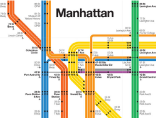- Massimo Vignelli
- The concept of total design based on a grid is also found in the work of Italian graphic designer Massimo Vignelli. In 1960, Vignelli and his wife, Lella, founded an office for design in Milan, The Lella and Massimo Vignelli Office for Design and Architecture. With experience in architecture, Vignelli established a vision of an organized, systematic structural approach early in his design career. Massimo, now strictly a grid-based designer, began exploration of the grid structure in Milan by working on corporate entities and projects for various cultural organizations. These early works allowed Vignelli to build a design style focused on dividing space within a modular grid into distinct zones. Breaking down the page into smaller intervals of space permitted a clear translation of complex informational material. The majority of his work utilizes a limited color palette and a small handful of typefaces.
- In 1965 Vignelli co-founded Unimark International Corporation, a design consultancy in Milan. A year later, Massimo and Lella moved to New York where they opened a Unimark branch specializing in the development of corporate logos and identity. Massimo and his wife have since established a new company, Vignelli Associates, in New York pursuing once again the grid philosophy with deigns for major firms, such as American Airlines, Bloomingdaleĺ─˘s and the International Design Center New York. While working for Unimark, Vignelli redesigned the look of the NYC Metropolitan Transit Authority with a new subway map and train identification sign system. Vignelli Replaced the previously chaotic typography with Helvetica and reduced the train routes down to solid color, while geometric lines organized the map and allowed signs to be clearer and more distinct. Vignelli continues to revise his modernist design of the New York City Subway Map, based on a simple grid with color-coded bars. Vignelli also applied his grid system to his design of the New York newspaper, The Herald. His use of a strict six-column grid and single typeface throughout the publication allowed The Herald to stand out from other newspapers with its clarity and legibility.
- In 1977, the Vignelli duo developed a system for the National Park Service in which they applied a modular grid to unify publications. Dividing the page with a series of horizontal bands allowed for numerous formats that could be imposed on a single piece of paper, reducing both paper waste and production time. The underlying structure of many of their endeavors in corporate identity, publication, book design, and interiors continues to be the reliable grid.


